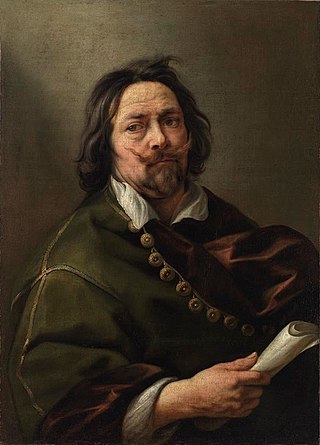
Jacob (Jacques) Jordaens was a Flemish painter, draughtsman and a designer of tapestries and prints. He was a prolific artist who created biblical, mythological, and allegorical compositions, genre scenes, landscapes, illustrations of Flemish sayings and portraits. After the death of Rubens and Anthony van Dyck, he became the leading Flemish Baroque painter of his time. Unlike those illustrious contemporaries he never travelled abroad to study the Antique and Italian painting and, except for a few short trips to locations elsewhere in the Low Countries, he resided in Antwerp his entire life. He also remained largely indifferent to Rubens and van Dyck's intellectual and courtly aspirations. This attitude was expressed in his art through a lack of idealistic treatment which contrasted with that of these contemporaries.

The Adoration of the Magi or Adoration of the Kings or Visitation of the Wise Men is the name traditionally given to the subject in the Nativity of Jesus in art in which the three Magi, represented as kings, especially in the West, having found Jesus by following a star, lay before him gifts of gold, frankincense, and myrrh, and worship him. It is related in the Bible by Matthew 2:11: "On entering the house, they saw the child with Mary his mother; and they knelt down and paid him homage. Then, opening their treasure chests, they offered him gifts of gold, frankincense, and myrrh. And having been warned in a dream not to return to Herod, they left for their own country by another path".

The Descent from the Cross, or Deposition of Christ, is the scene, as depicted in art, from the Gospels' accounts of Joseph of Arimathea and Nicodemus taking Christ down from the cross after his crucifixion. In Byzantine art the topic became popular in the 9th century, and in the West from the 10th century. The Descent from the Cross is the 13th Station of the Cross, and is also the sixth of the Seven Sorrows of the Blessed Virgin Mary.

The Elevation of the Cross is the name of two paintings, a very large triptych in oil on panel and a much smaller oil on paper painting. Both pieces were painted by the Flemish artist Peter Paul Rubens in Antwerp, Belgium, the original in 1610 and the latter in 1638. The original is a winged altarpiece, with the outside of the hinged wings also painted. These can be folded over the central panel, giving an 'open view' and a 'closed view'.

The Descent from the Cross is the central panel of a triptych painting by the Baroque artist Peter Paul Rubens in 1612–1614. It is still in its original place, the Cathedral of Our Lady, Antwerp, Belgium. The painting is considered to be one of Rubens' masterpieces. The painting depicts the moment when the body of Jesus Christ is taken down from the cross after his crucifixion. The subject was one Rubens returned to again and again in his career. The artwork was commissioned on September 7, 1611, by the Confraternity of the Arquebusiers, whose patron saint was St. Christopher.

Gaspar de Witte was a Flemish painter who is known for his landscapes and gallery paintings.

Willem van Herp (I) or Willem van Herp the Elder (variations on first name: 'Guilliam', 'Gilliam' and 'Guillaume') (c. 1614 in Antwerp – 1677) was a Flemish Baroque painter specializing in religious paintings and small cabinet paintings of "low-life" genre scenes. He operated a large workshop and through his good connections with Antwerp art dealers helped spread the Flemish Baroque style internationally.

The Nativity of Jesus has been a major subject of Christian art since the 4th century.

The Lamentation of Christ is a very common subject in Christian art from the High Middle Ages to the Baroque. After Jesus was crucified, his body was removed from the cross and his friends mourned over his body. This event has been depicted by many different artists.

Sir Peter Paul Rubens was a Flemish artist and diplomat. He is considered the most influential artist of the Flemish Baroque tradition. Rubens' highly charged compositions reference erudite aspects of classical and Christian history. His unique and immensely popular Baroque style emphasised movement, colour, and sensuality, which followed the immediate, dramatic artistic style promoted in the Counter-Reformation. Rubens was a painter producing altarpieces, portraits, landscapes, and history paintings of mythological and allegorical subjects. He was also a prolific designer of cartoons for the Flemish tapestry workshops and of frontispieces for the publishers in Antwerp.
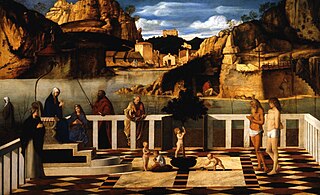
The Holy Allegory is a painting by the Italian Renaissance master Giovanni Bellini, dating from c. 1490 to 1500. It is in the Uffizi gallery in Florence, Italy.
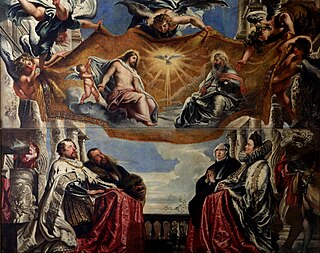
The Gonzaga Family in Adoration of the Holy Trinity is a painting by the Flemish artist Peter Paul Rubens, housed in the Ducal Palace in Mantua, Italy. The work was commissioned by Duke Vincenzo I Gonzaga for the Jesuit church in Mantua, while Rubens was his court painter.

The Judgement of Paris refers to any of the several paintings of the Judgement of Paris produced by Peter Paul Rubens, though he did not match the 22 depictions of the subject attributed to Lucas Cranach the Elder. There were versions before about 1606, then he returned to the subject thirty years later; all take the opportunity to show nude females from different angles.

The Last Supper (1630–1631) is an oil painting by Peter Paul Rubens. It was commissioned by Catherine Lescuyer as a commemorative piece for her father. Rubens created it as part of an altarpiece in the Church of St. Rombout (Rumbold) in Mechelen. The painting depicts Jesus and the Apostles during the Last Supper, with Judas dressed in blue turning back towards the viewer and away from the table. Other than Jesus, the most prominent figure is Judas. Judas holds his right hand to his mouth with his eyes avoiding direct contact with the other figures in the painting creating a nervous expression. Jesus is dressed in red and has a yellow halo surrounding his head with his face tilted upwards. Jesus is located centrally in the painting surrounded by his disciples with six on each side, and he holds a loaf of bread with a cup of wine in front of him. Out of all of the figures, he is the most in the light with the figures to the farthest left being the most in shadow. "The scene thus represents a perfect conflation of the theological significance of the Last Supper" meaning the conflation between the blessing of the bread and the wine while still being pivotal in the sense of revealing the betrayal.

The Bacchanal of the Andrians or The Andrians is an oil painting by Titian. It is signed "TICIANUS F.[aciebat]" and is dated to 1523–1526.

The Garden of Love is a painting by Rubens, produced in around 1633 and now in the Prado Museum in Madrid. The work was first listed in 1666, when it was hung in the Royal Palace of Madrid, in the Spanish king's bedroom. In early inventories, the painting was called The Garden Party.

The Rape of Ganymede is a painting by the Flemish Baroque painter Peter Paul Rubens produced between 1636 and 1638 painting for the Spanish king Philip IV of Spain's hunting lodge. The painting is based on a story recounted in classical poet Ovid's Metamorphoses. It depicts the moment when the Roman supreme god Jupiter disguised as an eagle catches the young shepherd Ganymede and lifts him into the air. It is in the collection of the Museo del Prado in Madrid. The dramatic scene gave Rubens ample opportunity to show his skill in depicting a lively scene and the nude.
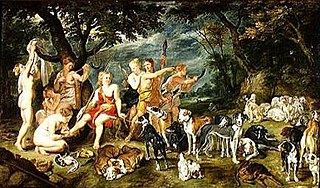
Diana and Her Nymphs Leaving for the Hunt is a 1623–1624 oil on panel painting by Peter Paul Rubens (figures) and Jan Brueghel the Elder. Diana It is now in the Musée de la Chasse et de la Nature in Paris. During his life, Rubens hoped to encourage the painting of classicist hunting scenes.

The Church of Our Lady of the Graces is a Gothic-style, Roman Catholic church in Varallo Sesia, province of Vercelli, region of Piedmont, Italy. The church was built, together with the adjacent Franciscan convent, by padre Bernardo Caimi between 1486 and 1493. At this time, the construction of the Sacro Monte was also beginning. In December 1931, Pope Pius XI gave the church the title of Minor Basilica.
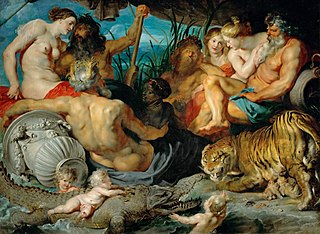
The Four Continents, also known as The Four Rivers of Paradiseor The Four Corners of the World, is a painting by Flemish artist Peter Paul Rubens, made between 1612 and 1615. Rubens painted this piece during a time of truce in the Eighty Years' War known as the Twelve Years' Truce. The painting depicts the female personifications of the four continents with the male personifications of their respective major rivers. The painting also depicts three putti in the foreground along with a crocodile, tigress, and her three cubs. An important figure in this piece is the woman in the middle who personifies Africa. She was one of the two black women Rubens painted at the time.




















